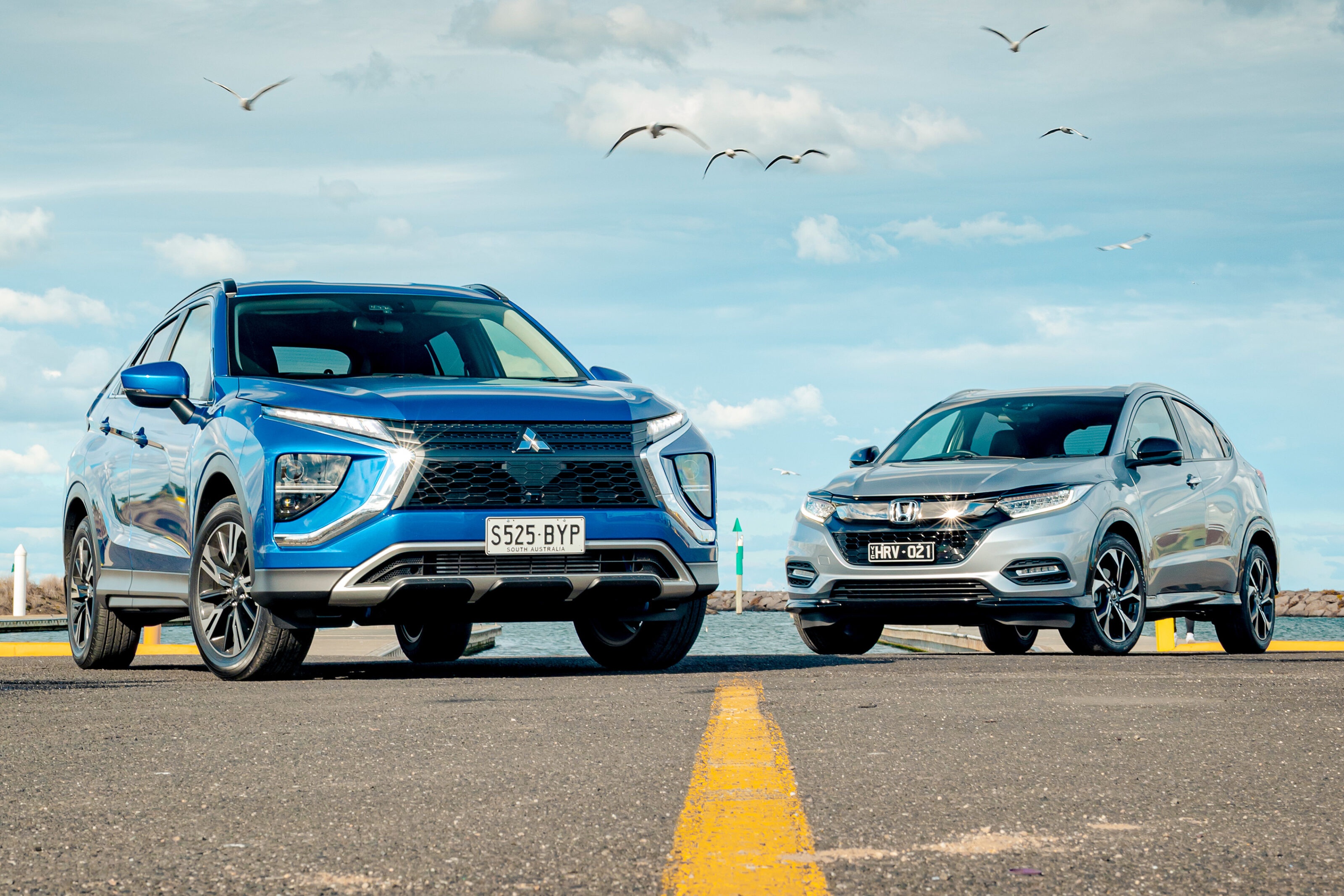
Ageing gracefully isn’t an easy task and it’s rarely successfully pulled off. In the SUV realm, the first-generation Volvo XC90’s 12-year run seems to be the best innings of them all.
Narrow down the form factor and do some light digging and it won’t take long to discover that the Mitsubishi Eclipse Cross and Honda HR-V aren’t exactly spring chickens. In fact, the latter’s origins can be found as far back as 2014, while the former, despite gaining a significant revamp at the end of 2020, first launched in 2017.
The problem facing this pair is that a lot has changed since their respective inceptions – and that’s without even factoring in a global pandemic. Both play in one of the most, if not the most, hotly contested segments within the new car market. Small SUVs are big business. Mitsubishi has long had a ‘good name’ in Australia, as has Honda, but it is now largely trading on a metal-for-your-money premise. So is that enough to give the Eclipse Cross the win?
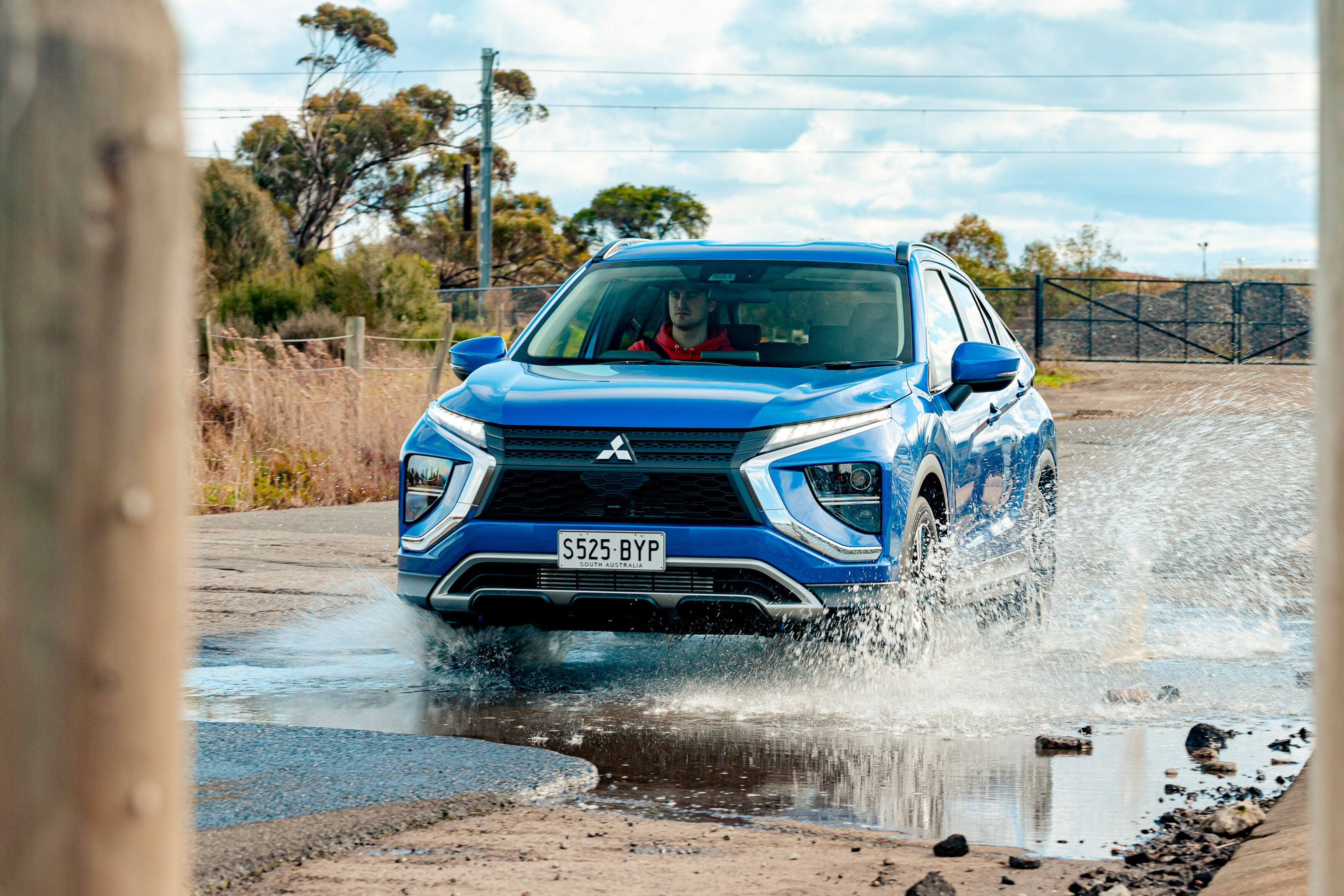
Speaking of size, the Mitsubishi’s aforementioned revamp added 140mm to its overall length, meaning it is now pushing the dimensional limits of the small SUV class. Still, at $35,090 before on-roads for the mid-spec LS AWD tested here, it matches up well with the tardis-esque Honda HR-V RS, which commands a $34,500 (plus costs) price tag.
The Eclipse Cross line-up starts at $30,290 for the base ES and extends to $40,790 for the range-topping Exceed AWD. The front-wheel-drive-only HR-V range starts at $25,990 for the VTi and tops out at $36,240 with the VTi-LX (all prices before on-road costs).
The ‘newest’ of this unlikely duo is the Mitsubishi, given it received a decent design makeover last year. Up front the Eclipse Cross has undergone a rhinoplasty with the ‘Dynamic Shield’ grille, while LED daytime running lights sit unconventionally above the halogen driving lights.
And despite growing in length – it’s now very much medium-sized compared to an ASX – the butt lift is the real talking point. Gone is the character-defining, but form over function, split rear windscreen that hampered visibility. In its place is a more conventional posterior, albeit a more generic one. The LED tail-lights that extend toward the roof are a nice styling touch.
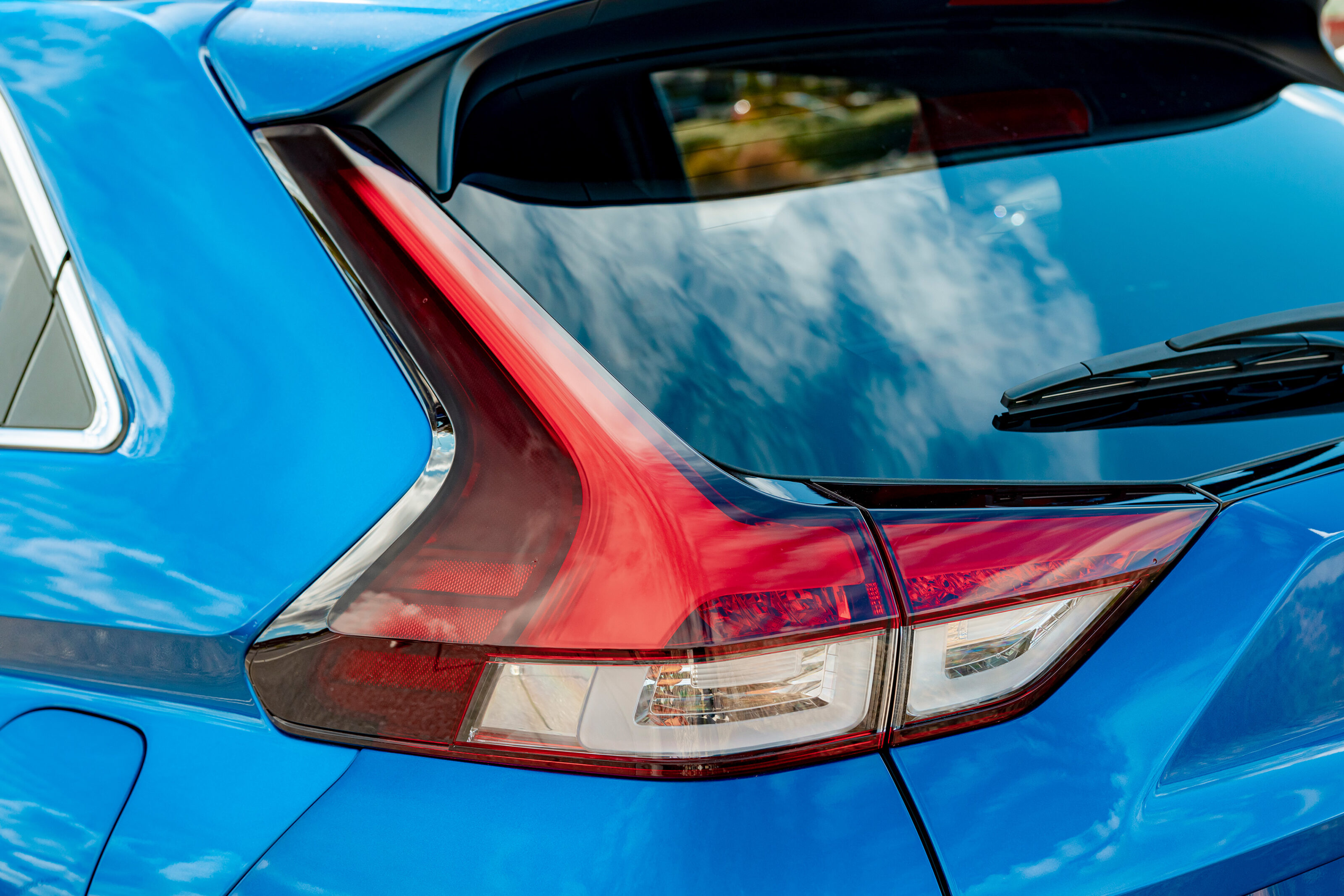
On the other side of the fence, the Honda design team did a little less with the latest iteration of the second-generation HR-V. Actually, it did nothing in terms of the exterior. Still, the smaller proportions suit the Jazz-based platform and the hidden rear door handles generate the illusion of a ‘funky’ three-door.
However, when loaded with shopping bags in hand, they’re a little fiddly and inconvenient to use. Like its rival, the HR-V rolls on 18-inch alloys and comes with ‘I can go off-road’ body cladding for the wheelarches and lower sections of the body. Few will try though, with both of these SUVs fighting the urban jungle – and often as family haulers.
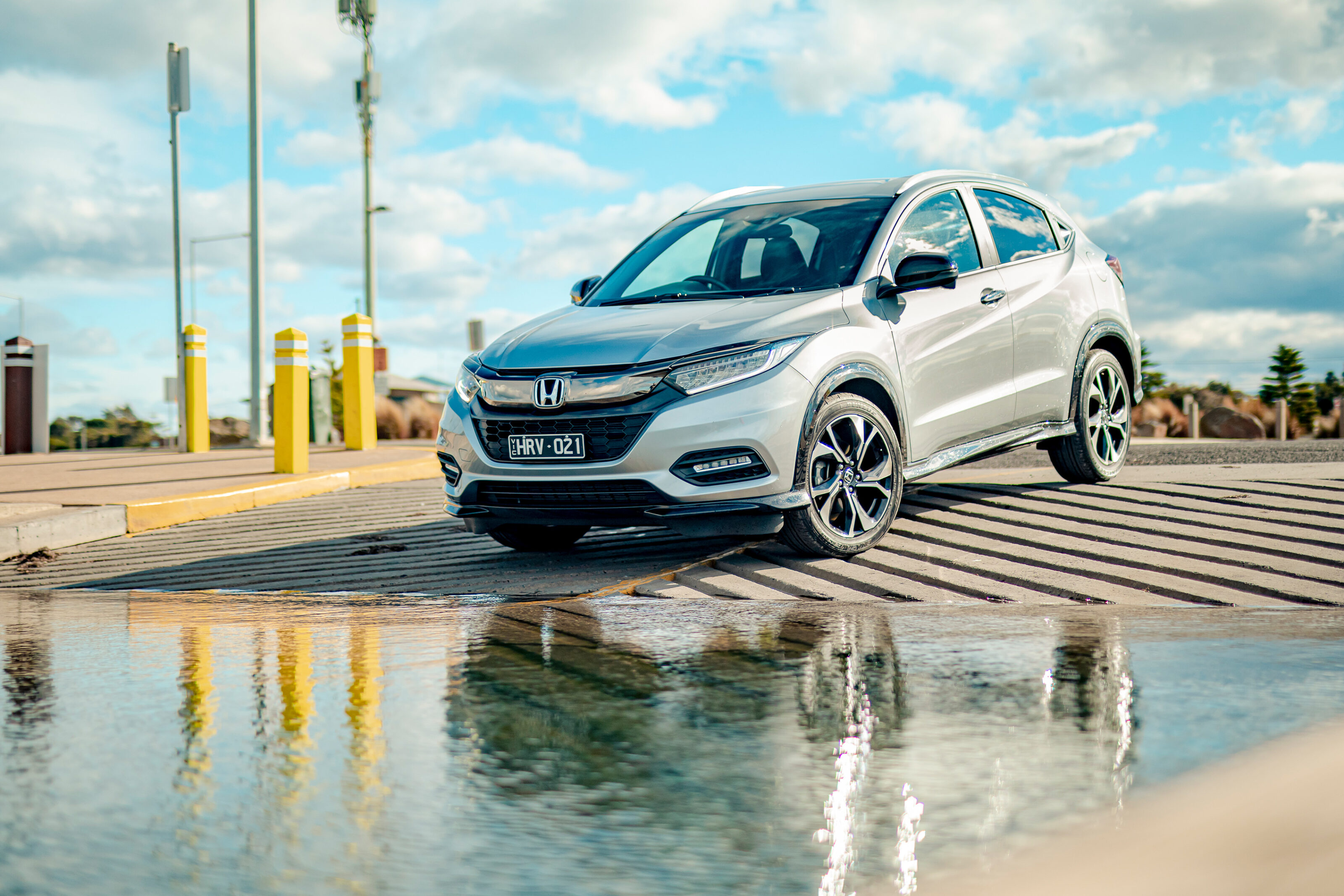
Inside is where divergent approaches can also be seen. And more importantly, felt. Despite a mid-$30K ask for the Eclipse Cross that already doesn’t quite scream bargain buying, the quality of materials used in the cabin don’t befit the price tag. Very little is soft-touch and it’s a mish-mash of colours and textures. For example, on top of the dark plastics, a silver finish is used on highlighted accents throughout as well as chrome, faux carbonfibre and piano black. A premium ambience it isn’t.
Alternatively, the HR-V does make you feel a bit special with the driver-focused layout that includes touchscreen climate control, a ‘floating’ centre console and soft leather upholstery (Eclipse Cross LS AWD uses cloth) – even the door cards gain plush materials. Despite the design being seven years old, it is ageing well. In terms of build quality, it’s another clear win to the HR-V, while ergonomics come in as a tie.
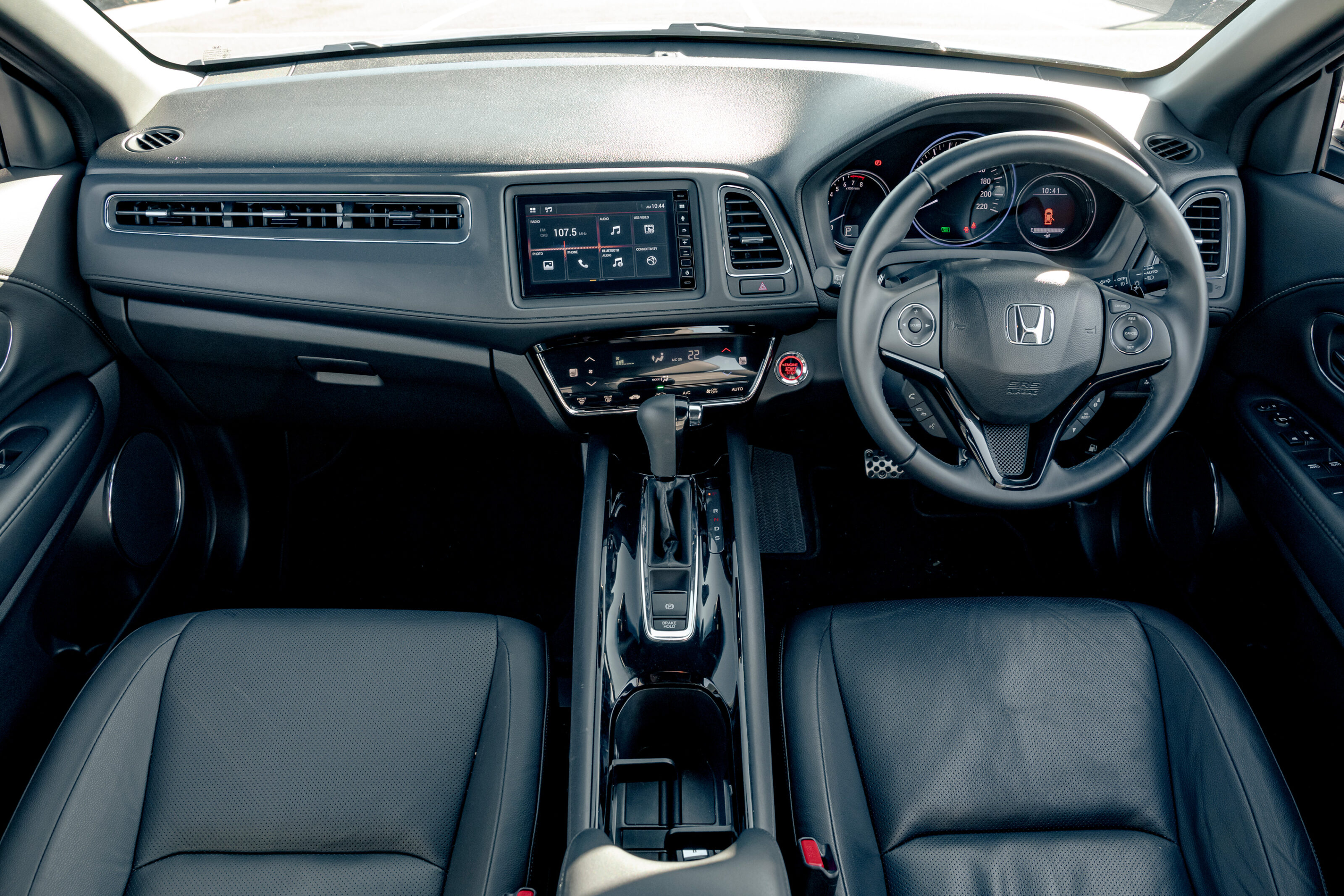
Both somewhat fail in terms of up-to-date technology. The Eclipse Cross now features a high-mount 8.0-inch central touchscreen with smartphone mirroring, while an electronic park brake is located where the fiddly touchpad controller used to live.
If screen size matters, then the Mitsubishi wins by an inch over the HR-V, which now has an infotainment display that looks slightly less aftermarket and the response time to inputs has improved. Thanks to an update in 2020, it also finally gains Apple CarPlay and Android Auto (to match the Eclipse Cross).
However, neither is brilliant. And in a sign of their age, wireless smartphone charging and cable-free mirroring is starkly missing in either SUV. What’s more, the graphics used in both systems are antiquated, there’s not a digital speedo to be seen and neither has USB charge ports or air vents in the back.
In a sign of their age, wireless smartphone charging and cable-free mirroring is starkly missing in either SUV
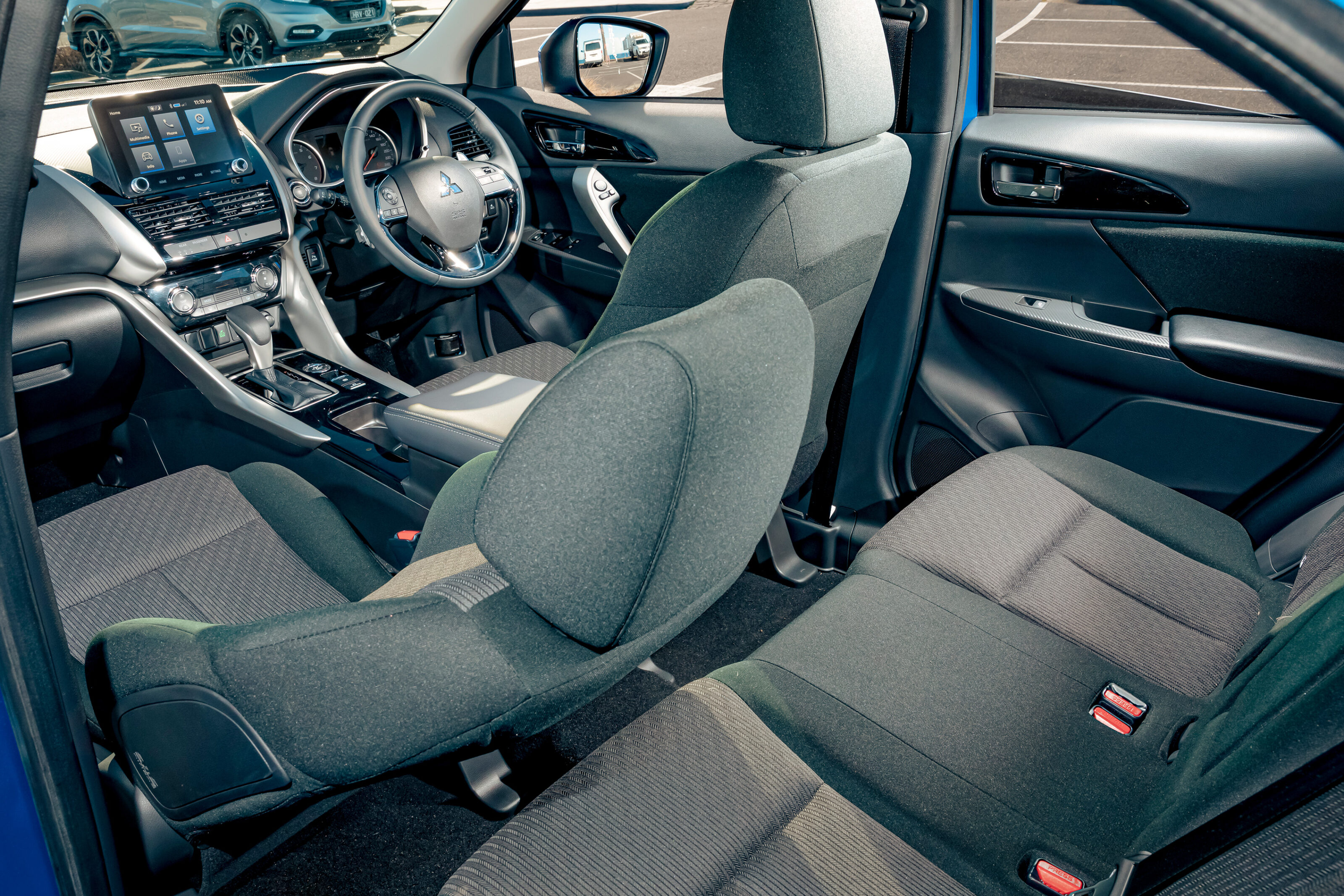
The Eclipse Cross utilises Mitsubishi’s well-used global GS platform, which also underpins the smaller ASX and larger Outlander. However, despite being endowed with a physically bigger body, the Mitsubishi is only nominally more spacious inside – shoulder room is the major differentiator.
The HR-V is 251mm shorter (4294mm), 33mm narrower (1772mm) and 80mm lower (1605mm) than the Eclipse Cross, yet head and legroom remain almost as generous. So if you’re after a smaller footprint with a commodious cabin, the HR-V offers a handy trump card in that regard.
Clinching the deal for Honda is the fact that the HR-V has a 437-litre boot compared to the Mitsubishi’s 405-litre capacity (which also lost its sliding rear bench in the facelift). With the rear seats folded (both operated via an in-cabin release) the former expands to 1462 litres, giving it a 13-litre advantage.
What’s more, the HR-V has Honda’s ‘Magic Seats’ that allow you to raise the seat bases for items like large pot plants or even TVs to be stowed. It’s possible due to the fuel tank being placed underneath the front seats instead of the rear. It also offers a completely flat load bay with the 60/40-split rear bench stowed. However, the removable parcel shelf is better resolved in the Eclipse Cross and it also has a flip-down centre armrest with in-built cup holders.

Relatively thick C-pilars hamper over-the-shoulder three-quarter vision in both – however, the Eclipse Cross has gargantuan wing mirrors to eschew blind sports – but sadly neither gains blind-spot monitoring for the spec levels tested. What Honda has to compensate is its LaneWatch technology that projects rearward vision (from the left-hand wing mirror only) onto the central infotainment screen. It’s a shame this is not available on the right-hand side, too.
Both have a five-star ANCAP safety rating, but with the Honda’s awarded in 2015 and the Mitsubishi’s in 2017, their active systems are lacking. For example, the HR-V has AEB but it’s only a low-speed setup and misses out on pedestrian/cyclist detection (unlike the Eclipse Cross).
Equally, they miss out on radar-guided cruise control, rear cross-traffic alert and lane-keeping assist – although the Eclipse Cross does have lane-departure warning via audio alerts. It is a sticking point when most of these features are becoming commonplace with other brands for entire ranges.
Honda’s five-year/unlimited-kilometre warranty is industry standard, but the 10-year capped-price servicing plan is impressive. The service intervals are quite short at 10,000km or once per year, with an average cost of $310 for every visit for the first three years.
Yet, it can’t match Mitsubishi’s 10-year/200,000km warranty and 10-year capped-price servicing (every year or 15,000km). It’s a true knockout for ownership peace of mind with each service costing, on average, $379 per check. But to get the full decade of cover you have to keep up your maintenance at a Mitsubishi dealership.
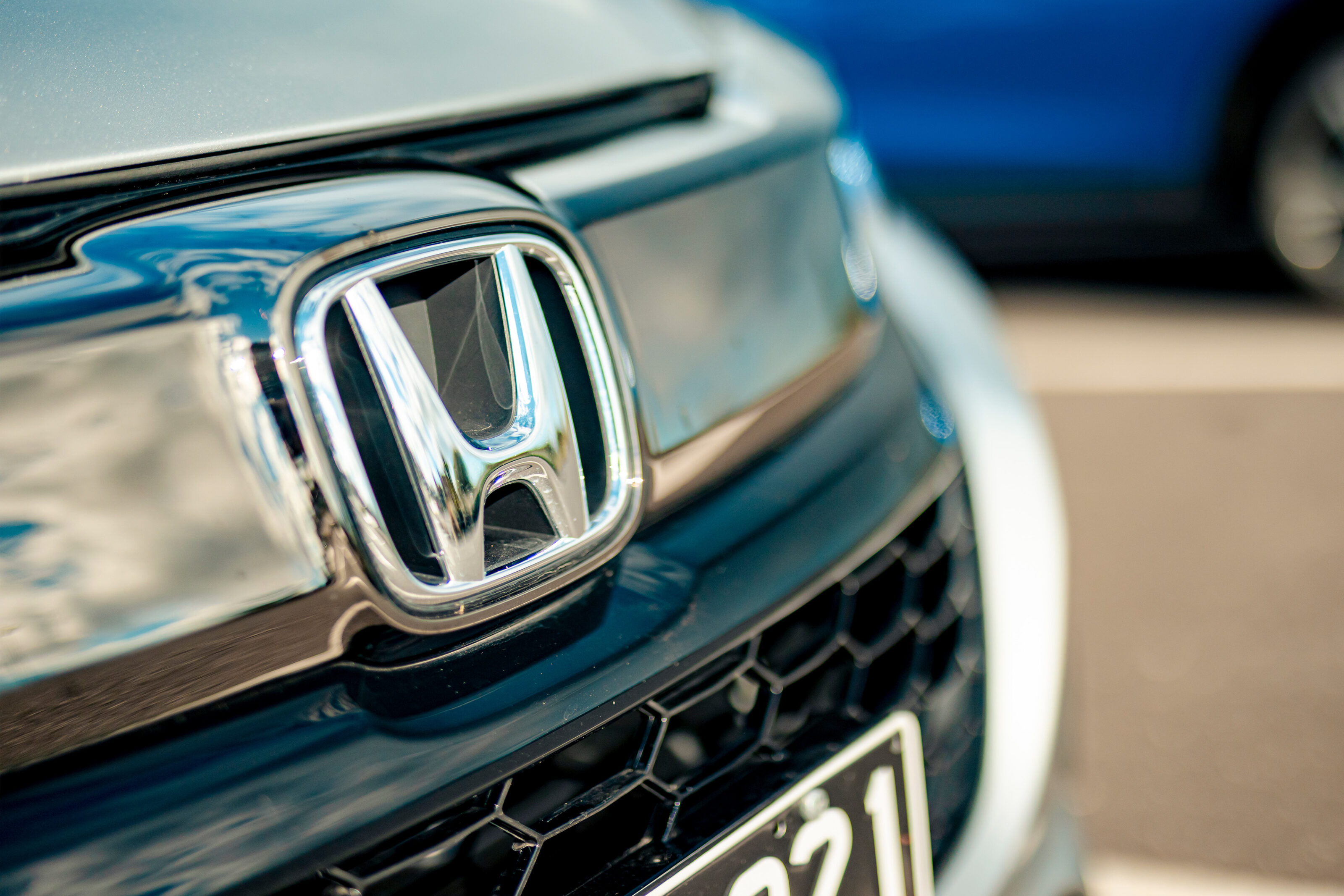
Mechanically, the Mitsubishi and the Honda go about their business differently – and one does a better job. Mitsubishi’s in-house 1.5-litre four-cylinder turbo-petrol engine is a bit of a cracker. Despite its diminutive cubic capacity, it packs a substantial 250Nm (from 2000rpm), which is the crucial figure compared to its 110kW. Despite the fact it weighs more than 1.5 tonnes, it shifts with purpose at step-off and it doesn’t totally run out of puff at the top-end as there is ‘enough’ grunt for highway overtakes.
The Continuously Variable Transmission (CVT) is one of the better examples of this gearbox type, and with stepped ratios it feels almost like a conventional torque-converter automatic. Oddly, Mitsubishi has also fitted the Eclipse Cross with some of the best paddle shifters in the business – which is a shame because you seldom, if ever, have to use them despite there being a dedicated manual mode. Maybe dreams of a return of the ‘Evo’ aren’t completely dead?
Oddly, Mitsubishi has also fitted the Eclipse Cross with some of the best paddle shifters in the business – which is a shame because you seldom have to use them
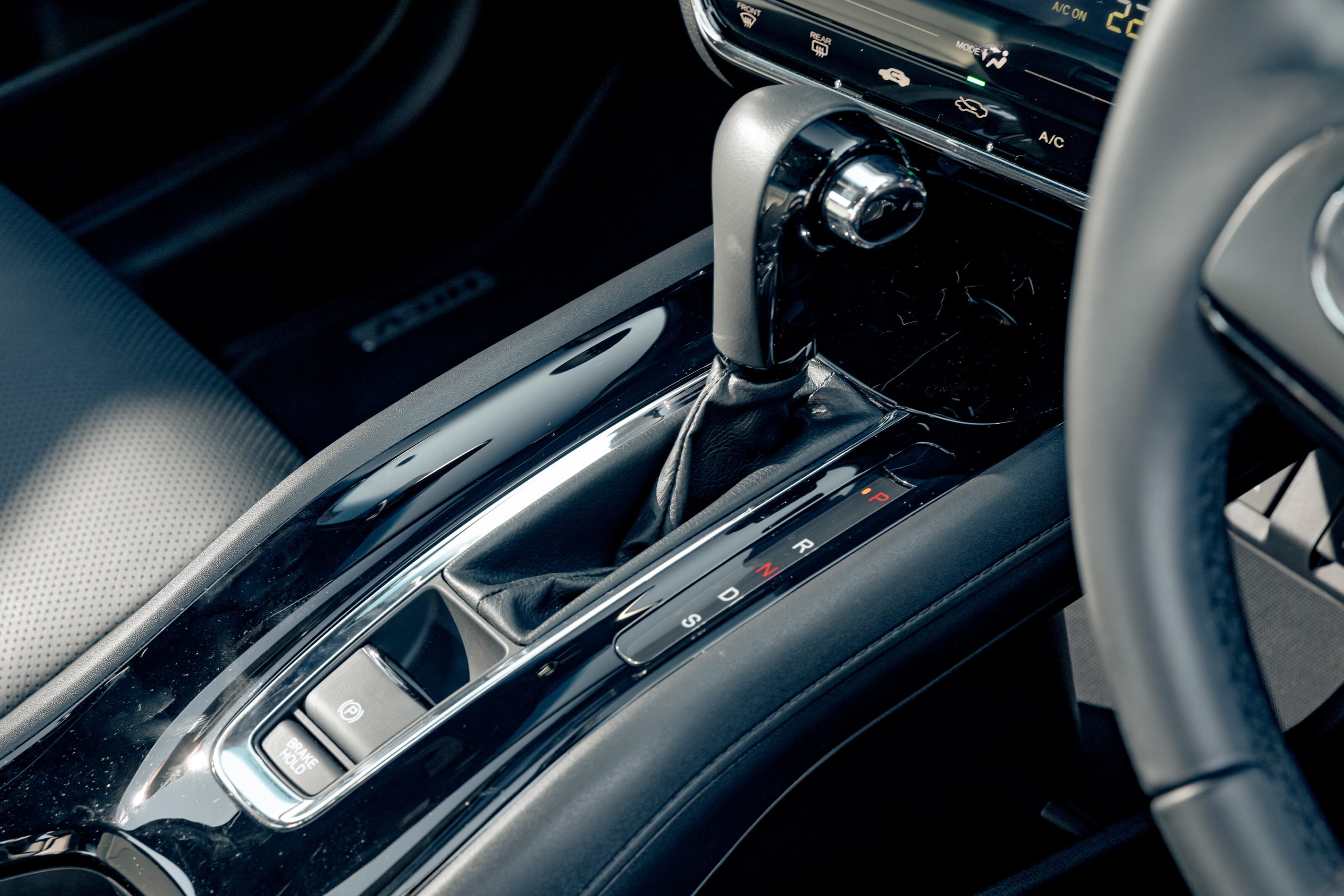
Honda’s naturally aspirated 1.8-litre four-pot has to deal with less heft due to its sub-1.3-tonne kerb weight, but the HR-V doesn’t have as much grunt to offer with 105kW and 172Nm. Its power is delivered higher in the rev range (6500rpm), and that, combined with the (stepped ratio) CVT, means it does drone and perch itself closer to redline more often.
It feels slightly slower than the Mitsubishi, but for city driving it’s more than adequate. What it really needs is an injection of Newtons, something the 1.5-litre four-cylinder turbo from the Civic would provide, but it isn’t available in the HR-V.
The Eclipse Cross will soon be offered with a hybrid drivetrain, a 2.4-litre four-cylinder setup snatched from the Outlander, which will help combined fuel consumption. We couldn’t match Mitsubishi’s 7.7L/100km claim, with our figures calculated at 8.5L/100km – not a bad result.
However, the Honda was even better, returning 7.2L/100km in testing compared to an official claim of 6.9L/100km. It’s a shame more fuel-efficient variants of the HR-V have never made it to our shores (given they’re available overseas), but an all-new third-generation model with fresh drivetrain options is due in 2022.
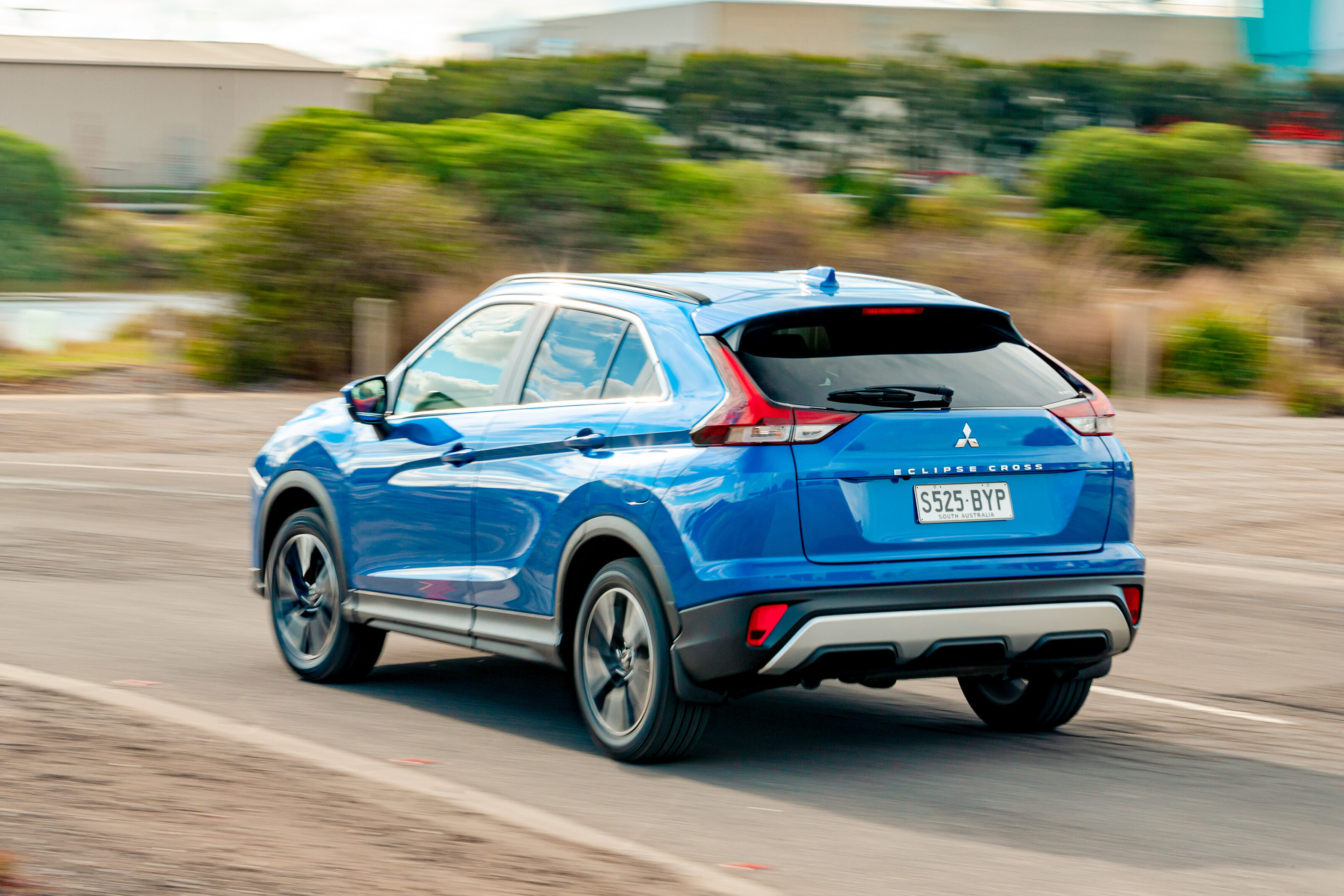
Previous testing of the front-wheel-drive Eclipse Cross has resulted in it performing poorly with its lack of purchase, especially with the Toyo rubber, being an issue. And that was in wet and dry conditions. Therefore, all-wheel drive is the better option for both traction and dynamics. Speaking of traction, there are three drive modes (Normal, Gravel and Snow), but it’s doubtful anyone is going to task this SUV with anything more than a smooth dirt road.
The steering and dampers were re-tuned with the last Eclipse Cross update, with both providing positive results. Ride quality is just supple enough at slow speeds over sharp potholes; however, big hits are heard and felt in the cabin. As the speed increases, there is no getting away from the SUV’s size and weight, with lateral body roll becoming an issue when cornering and during quick changes of direction.
This is where the HR-V feels much more nimble and agile, with its suspension and damper tune being better resolved on the rebound over smooth undulations – it certainly won’t bobble as much mid-corner and it is the quieter of the two in terms of road noise and NVH.
However, it does come at the expense of low-speed compliance, the Honda proving the firmer of the two over Melbourne’s numerous tram lines. Neither present as deal-breakers and both offer up a comfortable demeanour. It just depends on which is ‘right’ for you.
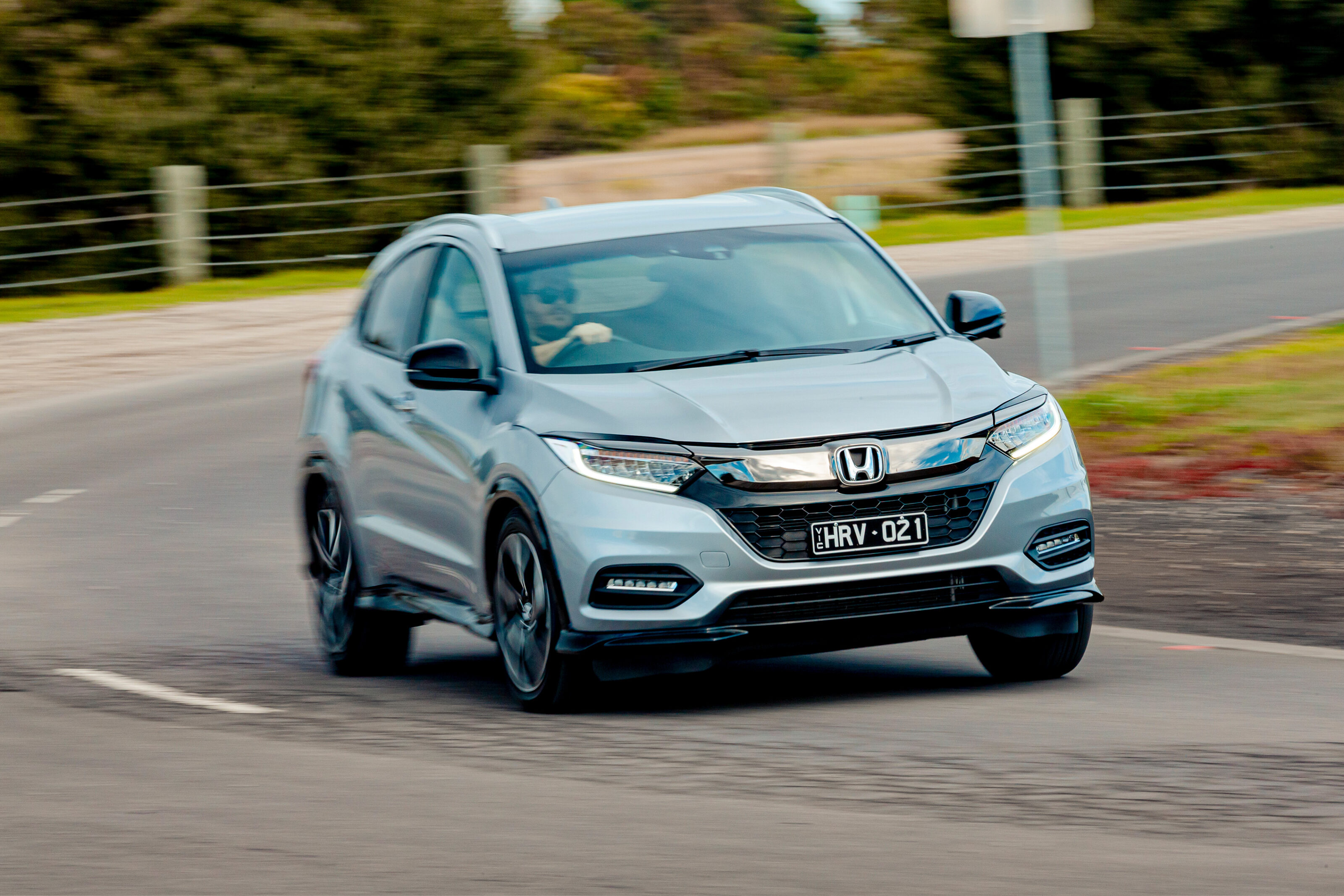
Ultimately, that’s the sentiment at the heart of this battle. Both offer a strong case in terms of space and versatility, while which design language tickles your fancy is a personal choice.
If the HR-V was fitted with the powertrain of the Eclipse Cross, it’d create a pretty compelling package.
As it stands, the pair receive the same score, but the Honda nudges ahead of the improved Mitsubishi with its premium cabin and origami-esque packaging.
However, while the HR-V and Eclipse Cross are doing their pragmatic best with what they have, numerous nips and tucks can’t quite mask the ageing process.
They’re solid options and are deserve consideration, but the segment has myriad worthy new faces.
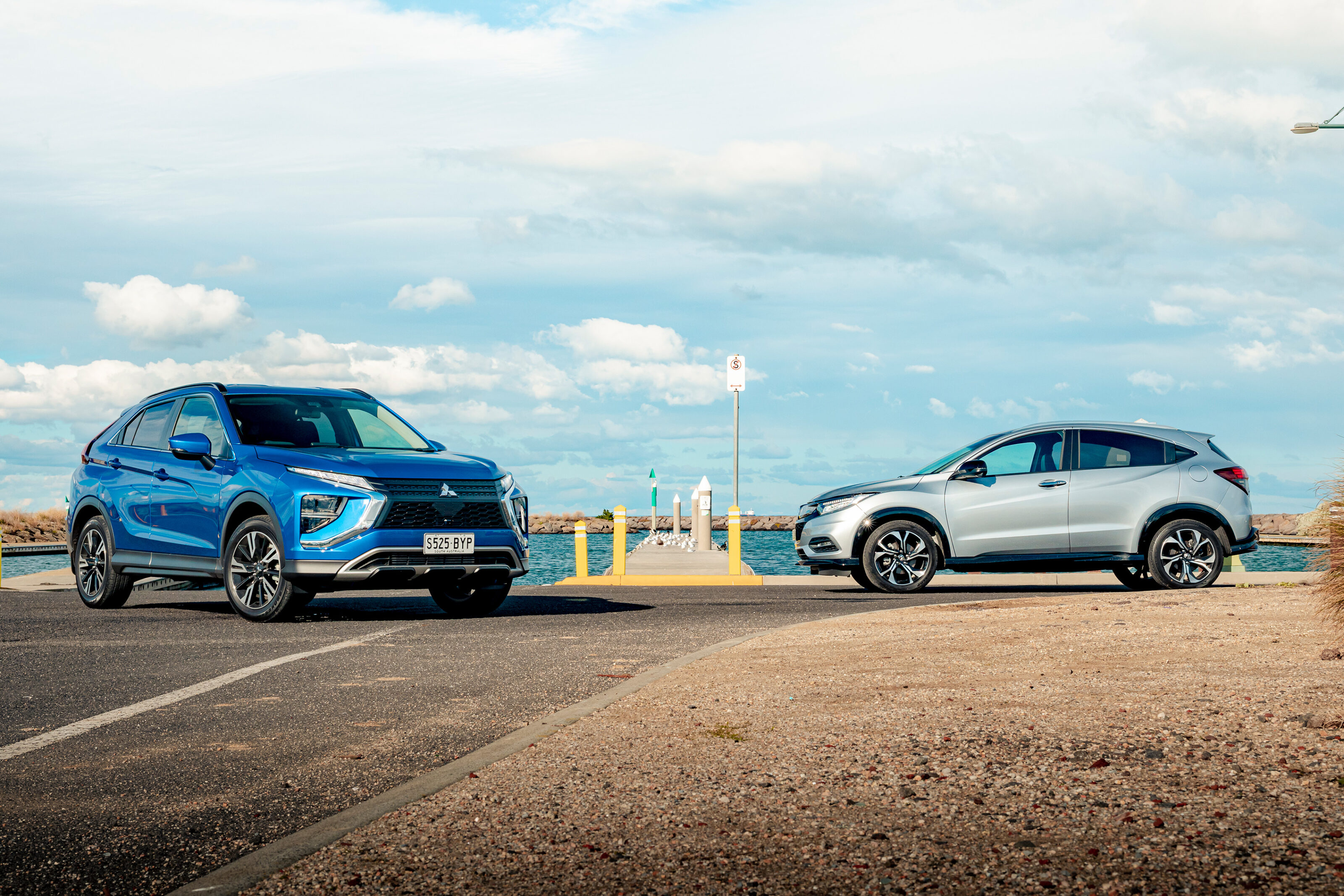
Specifications
| u00a0 | Mitsubishi Eclipse Cross | Honda HR-V RS |
|---|---|---|
| Body | 5-door, 5-seat SUV | |
| Drive | all-wheel | front-wheel |
| Engine | 1499cc inline-4, DOHC, 16v, turbo | 1799cc inline-4, DOHC, 16v |
| Bore/stroke | 75.0 x 84.8mm | 81.0 x 87.3mm |
| Compression | 10.0:1 | 10.6:1 |
| Power | 110kW @ 5500rpm | 105kW @ 6500rpm |
| Torque | 250Nm @ 2000-3500rpm | 172Nm @ 4300rpm |
| 0-100km/h | 9.8sec (est) | 10.2sec (est) |
| Fuel consumption | 7.7L/100km (combined/claimed) | 6.9L/100km (combined/claimed) |
| Weight | 1545kg | 1294kg |
| Power/weight | 71kW/tonne | 81kW/tonne |
| Transmission | CVT | |
| Suspension (front) | MacPherson struts, coil springs, anti-roll bars | |
| Suspension (rear) | Multi-links, coil springs, anti-roll bars/Torsion beam, coil springs, anti-roll bar | |
| L/W/h | 4545/1805/1685mm | 4294/1772/1605mm |
| Wheelbase | 2670mm | 2610mm |
| Tracks (f/r) | 1545/1545mm | 1535/1540mm |
| Steering | Electrically assisted rack-and-pinion | |
| Brakes | ventilated discs (f); solid discs (r) | |
| Wheels | 18.0 x 7.0-inch (f/r) | |
| Tyres | 225/55 R18 98H (f/r) Toyo | 225/50 R18 95V (f/r) Dunlop Ensave EC 503 |
| Price | $35,090 | $34,500 |




